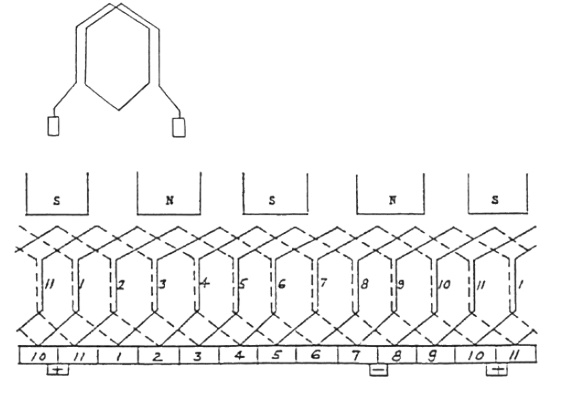Chapter: Electrical machines : DC Generators
Wave Winding
Wave
Winding
This type
of winding is used in dc generators employed in high-voltage applications.
Notice that the two ends of each coil are connected to commutator segments
separated by the distance between poles. This configuration allows the series
addition of the voltages in all the windings between brushes. This type of
winding only requires one pair of brushes. In practice, a practical generator
may have several pairs to improve commutation. When the end connections of the
coils are spread apart as shown in Figure a wave or series winding is formed.
In a wave winding there are only two paths regardless of the number of poles.
Therefore, this type winding requires only two brushes but can use as many
brushes as poles. Because the winding progresses in one direction round the
armature in a series of 'waves' it is know as wave winding.If, after passing
once round the armature,the winding falls in a slot to the left of its starting
point then winding is said to be retrogressive.If, however, it falls one slot
to the right, then it is progressive.

1.
YF are odd and of the same sign.
2.
Back and front pitches are nearly equal to the pole
pitch and may be equal or differ by 2, in which case, they are respectively one
more or one less than the average pitch.
3.
Resultant pitch YR = YF + YB.
4.
Commutator pitch, YC = YA (in lap winding YC = ±1
). Also YC = (No.of commutator bars ± 1 ) / No.of pair of poles.
5.
The average pitch which must be an integer is given
by YA = (Z ± 2)/P = (No.of commutator bars ± 1)/No.of pair of poles.
6.
The number of coils i.e NC can be found from the
relation NC = (PYA ± 2)/2.
7.
It is obvious from 5 that for a wave winding, the
number of armature conductors with 2 either added or subtracted must be a
multiple of the number of poles of the generator. This restriction eliminates
many even numbers which are unsuitable for this winding.
8.
The number of armature parallel paths = 2m where
'm' is the multiplicity of the winding.
Related Topics